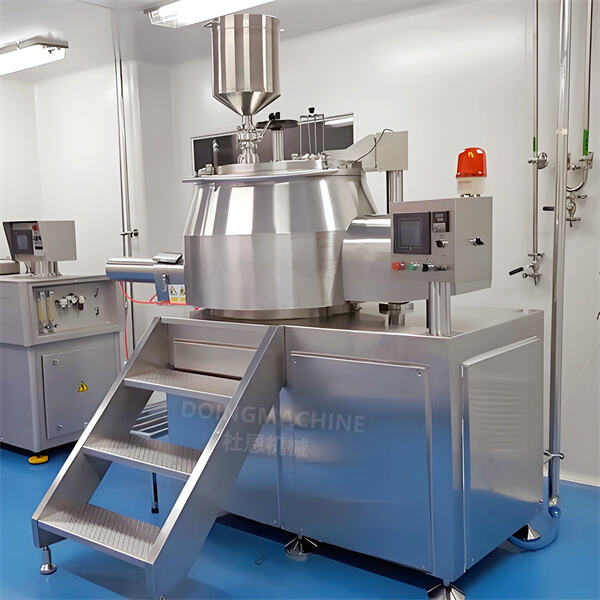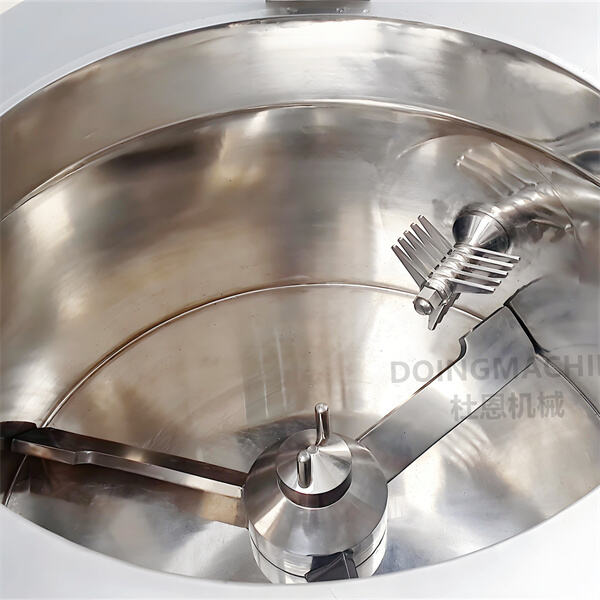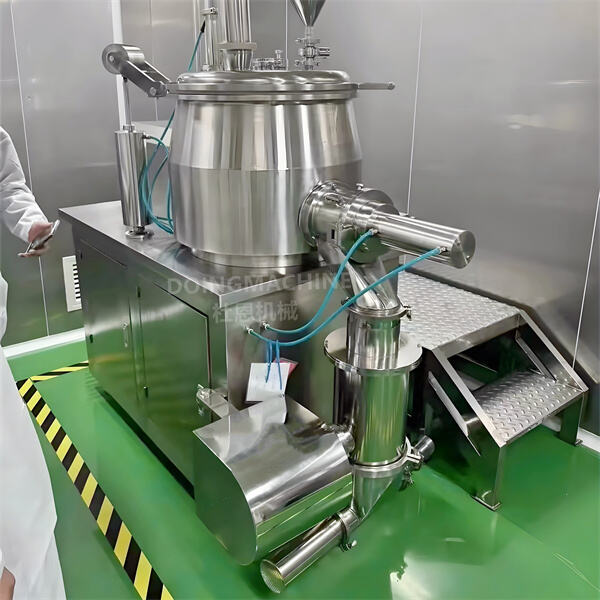เพื่อทํายา ขั้นตอนแรกคือการรวมส่วนประกอบทั้งหมด สารเหล่านี้คือสารประกอบที่ใช้เป็นยา สารผูกพันเหล่านี้ทําให้ยาถือตัวเอง และเต็มสารเติม เพื่อให้ยามีขนาดและรูปร่างที่เหมาะสม ดังนั้นต้องให้แน่ใจว่าผสมทุกอย่างให้ดี เพราะสิ่งสําคัญคือ มันจะช่วยกระจายสารประกอบที่ใช้ได้ทั่วเม็ด ขั้นตอนนี้สําคัญมาก เพราะยาบางชนิดจะทํางานได้ดีกว่ายาอื่น ๆ หากส่วนประกอบไม่ได้ผสมกันอย่างถูกต้อง
หลังจากผสมส่วนประกอบแล้ว เราจำเป็นต้องเทน้ำลงไป โดยระมัดระวังให้เติมน้ำเพียงเล็กน้อยตามที่จำเป็น หากเราเติมน้ำมากเกินไป วัสดุจะชื้นเกินไปและไม่สามารถปั้นเป็นเม็ดยาได้ แต่ถ้าใส่น้ำน้อยเกินไป ส่วนผสมจะแห้งและแตกเป็น vụn ในขั้นตอนนี้เรามุ่งเน้นเติมน้ำให้พอดีจนส่วนผสมเหนียวพอที่จะรวมกันเป็นชิ้นเล็กๆ ที่เรียกว่าแกรนูล และความเหนียวในขั้นตอนนี้มีความสำคัญสำหรับการสร้างรูปแบบของยาในขั้นตอนถัดไป
หลังจากเติมน้ำในปริมาณที่ต้องการแล้ว เราจะ proceed to wet เครื่องอัดเม็ดแบบเอ็กซ์ทรูเดอร์ . ในขั้นตอนนี้ เราจะทำการผสมใหม่ทั้งหมดเพื่อให้เกิดเป็นก้อนเล็กๆ ที่เรียกว่า granules โดย granules เหล่านี้คือชิ้นส่วนเล็กๆ ที่เราจะนำมาใช้ในการผลิตเม็ดยา การทำ wet granulation จะช่วยให้ส่วนผสมถูกคลุกเคล้ากันอย่างสม่ำเสมอ และสามารถอัดเป็นเม็ดยาในขั้นตอนต่อไปได้ ส่วนนี้เจ๋งมากเพราะคุณกำลังสร้างสิ่งใหม่ขึ้นมาเลย
จากนั้น เราจำเป็นต้องทำการอบ granules ที่ยังเปียกซึ่งเราได้ทำไว้ การอบเป็นกระบวนการที่สำคัญมาก เพราะจะช่วยกำจัดน้ำส่วนเกินออกจาก granules หากเราไม่ทำการอบ วัตถุดังกล่าวจะยังชื้นเกินไปและไม่สามารถผลิตเม็ดยาได้ โดยปกติแล้ว เราจะนำสารนี้ไปใส่ไว้ในเตาอบเพื่อทำการอบแห้ง โดยกระบวนการอบนี้จะช่วยทำให้ granules มีความแข็งแรง เมื่อ granules แห้งแล้วก็พร้อมนำไปอัดเป็นเม็ดยาได้ ขั้นตอนนี้คล้ายกับการอบคุกกี้ ซึ่งเราต้องทำให้ถูกต้องก่อนที่จะดำเนินการในขั้นตอนต่อไป!

สุดท้ายแต่ไม่ท้ายสุด เราได้มาถึงขั้นตอนล่าสุดของกระบวนการวัสดุผสมละเอียดพิเศษ นั่นคือ การอัดก้อน ซึ่งขั้นตอนนี้จะเกี่ยวข้องกับการอัดเม็ดวัสดุที่แห้งแล้วให้เป็นรูปแบบเม็ดยา เราใช้อุปกรณ์เฉพาะที่เรียกว่าเครื่องอัดเม็ดเพื่อจุดประสงค์นี้ ซึ่งช่วยให้สะดวกและเพิ่มความเร็วในการดำเนินการ เมื่อเม็ดวัสดุถูกอัดเป็นรูปแบบก้อนแล้ว เราจะทำการเคลือบเม็ดยานั้น อันตรายในการเคลือบคือการทำให้ยานั้นทานง่ายขึ้น ปกป้องเม็ดยาจากความชื้น และเพื่อจุดประสงค์ทางด้านความสวยงาม เปรียบเสมือนการใส่ครีมแต่งหน้าเค้กเลยทีเดียว เครื่องคัดกรองสั่นสะเทือน อุปกรณ์ที่ใช้สำหรับกระบวนการอัดเม็ดนี้เรามีเครื่องเฉพาะทางที่เรียกว่า เครื่องอัดเม็ด ซึ่งช่วยให้ง่ายต่อการใช้งานและเพิ่มความเร็วในการผลิต เมื่อเม็ดวัสดุถูกอัดเป็นเม็ดยาแล้ว เราจะทำการเคลือบเม็ดยาเพื่อทำให้เม็ดยานั้นรับประทานง่ายขึ้น ปกป้องเม็ดยาจากความชื้น และเพื่อความสวยงาม คล้ายกับการใส่หน้าเค้กด้วยครีมเลยทีเดียว

การสร้างอนุภาคแบบเปียกมีบทบาทสำคัญในกระบวนการผลิตยาเม็ด แต่เป็นกระบวนการที่ใช้เวลานานและมีค่าใช้จ่ายสูง และหากเราต้องการปรับปรุงกระบวนการและความมีประสิทธิภาพ ก็จำเป็นต้องรวมวัตถุดิบคุณภาพสูง การควบคุมปริมาณน้ำที่เพิ่มเข้าไปก็มีความสำคัญเช่นกัน เพื่อให้ได้ความสม่ำเสมอของสารผสม นอกจากนี้ยังต้องตรวจสอบขั้นตอนการอบและการกด เพราะจะเป็นตัวกำหนดพลังงานที่ชิ้นส่วนจะได้รับ เครื่องจักรยังสามารถเร่งกระบวนการและลดต้นทุนการประมวลผล ซึ่งเป็นประโยชน์สำหรับทุกคน

วิธีการผลิตเม็ดยาประกอบด้วย กระบวนการแกรนูเลชันแบบเปียก , การปั้นเม็ดแบบแห้ง (dry granulation) และการอัดเม็ดโดยตรง (direct compression) แม้ว่าวิธีการแต่ละแบบจะมีจุดแข็งและจุดอ่อนที่แตกต่างกัน แต่การเลือกใช้วิธีการนั้นจะขึ้นอยู่กับข้อกำหนดเฉพาะของเม็ดยาที่ผลิต หากรูปแบบอื่นไม่สามารถใช้ได้ แต่ต้องการเม็ดยามีความแข็งแรงทนทาน โดยมีแนวโน้มแตกหรือร้าวน้อยกว่า ก็มักจะเลือกใช้การปั้มน้ำ (wet granulation) เพื่อแก้ไขปัญหาความสามารถในการอัดเม็ดของสารออกฤทธิ์ วิธีนี้มักใช้เมื่อสารออกฤทธิ์ไวต่อความร้อนและมีความไวต่อความชื้น รวมถึงในกรณีที่ต้องการให้สารออกฤทธิ์ค่อยๆ ถูกปล่อยออกมาช้ากว่าส่วนอื่นๆ ของส่วนผสม การอัดเม็ดโดยตรงมักถูกนำมาใช้หลักเมื่อสารออกฤทธิ์สามารถอัดเม็ดได้ง่าย และต้องการให้สารออกฤทธิ์ถูกปล่อยออกมาอย่างรวดเร็ว
ลูกค้าสามารถทดลองใช้อุปกรณ์และสำรวจวัสดุได้โดยไม่มีค่าใช้จ่าย เพื่อช่วยให้พวกเขาเข้าใจถึงประสิทธิภาพของอุปกรณ์และตัดสินใจว่าเหมาะสมกับความต้องการเฉพาะของพวกเขาหรือไม่ สิ่งนี้ช่วยเพิ่มความมั่นใจให้กับลูกค้าที่เป็นไปได้เมื่อทำการซื้อ บริษัทมีพนักงานหลังการขายที่มีประสบการณ์และทักษะสูง ซึ่งจะตอบสนองอย่างรวดเร็วต่อคำขอและให้บริการหลากหลาย เช่น การติดตั้ง การเปิดใช้งาน และการฝึกอบรม เพื่อให้มั่นใจในปฏิบัติการของอุปกรณ์อย่างมีประสิทธิภาพและลดเวลาหยุดทำงาน
แต่ละดีไซน์มีความเป็นเอกลักษณ์สำหรับวัสดุแต่ละประเภท โดยอิงจากประสบการณ์การผลิตจริง ข้อมูลการทดสอบ และสายตาที่ละเอียดอ่อนต่อรายละเอียด ซึ่งช่วยให้อุปกรณ์แต่ละชิ้นสามารถตอบสนองความต้องการที่หลากหลายของวัสดุและข้อกำหนดในการผลิตตามที่ลูกค้าต้องการ ทำให้เพิ่มประสิทธิภาพและความคล่องตัวในการผลิต นอกจากนี้ยังมีโรงงานทดลองแบบมืออาชีพที่สามารถทำการทดสอบเบื้องต้นและการจำลองการผลิตได้ พร้อมทั้งให้การสนับสนุนที่แข็งแกร่งสำหรับการออกแบบเฉพาะที่ช่วยลดความเสี่ยงในการลงทุนและเพิ่มโอกาสในการประสบความสำเร็จกับโครงการ
ตั้งแต่ปี 1995 บริษัทได้ดำเนินการมาตั้งแต่ปี 1995 และมีประสบการณ์มากกว่าสามปีในด้านการผลิตเครื่องจักรอุตสาหกรรม โดยสะสมความรู้ทางเทคนิคและความเข้าใจเกี่ยวกับอุตสาหกรรมอย่างลึกซึ้ง รวมถึงความสามารถในการตอบสนองความต้องการการผลิตที่ซับซ้อนหลายประการ บริษัทมีวิศวกรที่มีความเชี่ยวชาญในด้านนี้มากกว่า 30 ปี ซึ่งมีความชำนาญในด้านการผลิต การออกแบบและการปรับปรุงสำหรับเครื่องจักรอุตสาหกรรมหลากหลายประเภท สิ่งนี้มอบการรับประกันที่แข็งแกร่งในเรื่องคุณภาพของสินค้าและความมีประสิทธิภาพ
บริษัทได้ขายสินค้าให้กับลูกค้าจำนวนมาก พวกเขารับการยอมรับจากลูกค้าหลายพันคน ซึ่งแสดงให้เห็นว่าสินค้าของพวกเขาเชื่อถือได้และมีประสิทธิภาพที่น่าเชื่อถือ บริษัทมุ่งมั่นที่จะมอบเครื่องจักรคุณภาพสูงให้กับลูกค้า ผลิตภัณฑ์ บริการ และชื่อเสียงที่มีคุณภาพสูงช่วยให้บริษัทได้รับความไว้วางใจจากลูกค้าในระยะยาว

ลิขสิทธิ์ © Changzhou Doing Machine Co., Ltd. สงวนสิทธิ์ทั้งหมด | บล็อกครับนโยบายความเป็นส่วนตัว